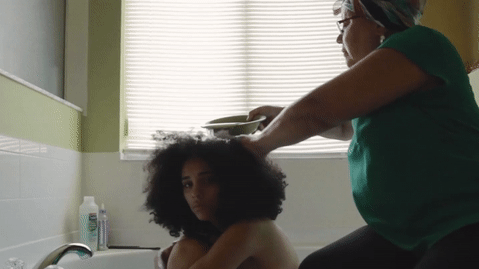
De Los Angeles, her mother, and her grandmother—three different generations of a family—represent a triptych of constructive conflict, reflection, and care that are necessary for healing.
“What happens to brown girls who never learn how to love themselves brown?” The question is a line of poetry, the voice of an omnipresent narrator. It is also the inquiry that the short film “The Ritual to Beauty,” directed by Shenny De Los Angeles and Maria Marrone, seriously attempts to answer. Their work depicts De Los Angeles’s family—three women from the Dominican Republic—and the beauty rites they practice that honor their cultural and racial identities. De Los Angeles’s grandmother erased evidence of her African ancestry from her own tresses. Having passed this ritual on, she says, “I was the one that ruined my daughter’s hair.” As a young girl, De Los Angeles made similar choices. Her curly mane stood out, and all she wanted to do was to blend in, so she begged her mother for “the desrizado,” to take the kinks out of her hair. “The Ritual to Beauty” is an exercise in healing from the generational trauma that her mother and grandmother survived.
In an early scene, De Los Angeles scours a bathtub and builds an altar, on which photos of her mother and grandmother wearing their hair natural and a copy of Ntozake Shange’s “Wild Beauty” sit in a place of honor. She is cleansing the space, performing a ritual inspired by a religion that she practices called Lukumí. As she continues the ritual, a voice addresses the viewer, speaking a poem that De Los Angeles wrote, which inspired the film; its speaker is the Yoruba spirit Yemaya—the “mother of seas.” De Los Angeles thinks of Yemaya’s voice as “the most divine version of yourself,” she recently told me over Zoom, with her bountiful curls occupying most of the frame. “That voice within you that’s uplifting you and challenging you, and showing you to take up space, to surrender, and heal.”
The New Yorker Documentary
View the latest or submit your own film.

Marrone and De Los Angeles grew up together in Kissimmee, Florida, and both women are now twenty-seven. When framing the hair sequences, Marrone said that she wanted those scenes to be tight and delicate—the narrow angles mirror fingers combing through tiny knots. De Los Angeles’s elders internalized some of the Dominican Republic’s racist history; a method of their survival was conformity. De Los Angeles’s grandmother is Afro-Dominican, and her mother is biracial. They placed “fire” at their scalps, and straightened the Africanness out of their hair. Once she came of age, De Los Angeles had the freedom and the courage to choose otherwise. These women, of three different generations, represent a triptych of constructive conflict, reflection, and care that are necessary for healing.
When De Los Angeles trims her grandmother’s salt-and-pepper hair, wispy strands fly into the air. In another scene, a curling iron presses tight against her mother’s roots. De Los Angeles’s poem rolls on. “If our ritual to beauty is setting our crown on fire . . . if beauty really is pain, if that’s what we tell ourselves, how do we love without hurting ourselves?” The friends had two creative goals: to tell a story of one family’s complex relationships with their hair and beauty, and to capture the spirit of that poem in a film. “There’s always this kind of translation that has to happen when you cross over mediums, and a big thing is we really wanted the imagery to serve the writing,” Marrone said. “How can we still capture the essence of what this story is meant to make you feel?”
Hair is a talisman in the film, a symbol of so many elements of identity. “I found photos of my mom at twenty-one when she did go natural, and I could see a biracial girl for the first time,” De Los Angeles said. “I think now I have a better understanding of a lot of the privileges I hold being racially ambiguous. . . . We also experience our Blackness different. Me and my mom don’t share what my grandmother shares in her body. To my grandma, I am white, and that is a very nuanced, complicated conversation.” As for herself, De Los Angeles told me that, these days, her hair journey “isn’t that deep,” and that’s the “beautiful part about it.”
Sourse: newyorker.com